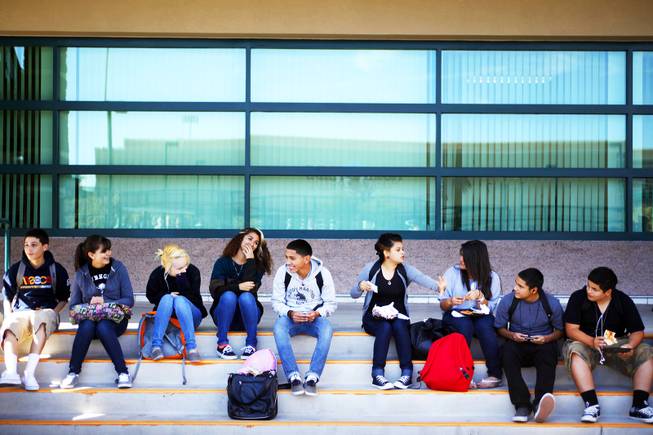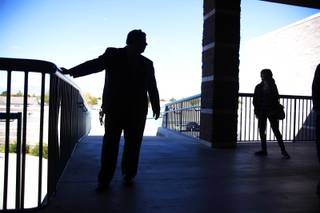
Students eat lunch in the quad at Mojave High School in North Las Vegas on Thursday, Nov. 17, 2011.
Saturday, Nov. 26, 2011 | 2 a.m.
Sun archives
This is another in a yearlong series of stories tracking Clark County School District’s efforts to turn around five failing schools.
Greg Cole is in the middle of an important meeting with a parent conflicted about sending his son to the perennially struggling Mojave High School when the bell rings.
The burly assistant principal jumps up from his desk and grabs his walkie-talkie. He politely excuses himself from his office and charges out to the school quad teeming with students.
“Good morning,” Cole says, offering a fist bump to a student. “What’s up, buddy? Learn something today, all right?”
He walks a few paces over. “How are you?” he asks another passing student.
“Bad,” she replies, holding up two fingers taped together.
Cole shoots her a concerned look, but quickly smiles. “Thanks again for your help with the student council stuff yesterday.”
It might seem unorthodox for an administrator to leave a parent twiddling thumbs in an office for five minutes. Cole admits he gets a few raised eyebrows from time to time, but he doesn’t mind. He knows whom he is serving.
“What we do here is for the kids,” he said. “It’s not about the adults.”
At every five-minute break between classes, Cole and about a dozen administrators, hall monitors, police officers and teachers are out and about, monitoring the school grounds. They’re walking hallways, interacting with students and checking the bathrooms for signs of mischief.
Mojave has earned a rough reputation over the years: Students bringing guns to school, vandals spray-painting gang signs on walls and marijuana being smoked in the bathroom.
When Principal Antonio Rael first stepped foot on campus for an interview this year, he saw three fights break out over a 10-minute period during lunch. He knew something had to change.
“That was disconcerting since it disrupts your entire campus,” Rael said. “We have to be proactive. It’s about knowing about the problems before they escalate.”
•••
Earlier this year, the Clark County School District implemented a “turnaround” model at the troubled North Las Vegas high school, which had one of the lowest graduation rates and test scores in the valley. The school replaced the majority of its staff and implemented a bevy of changes using nearly a million dollars in federal stimulus money.
Part of the School Improvement Grant went toward a three-day workshop called Capturing Kids’ Hearts, which helps schools connect with its at-risk students. Teachers were encouraged to shake students’ hands at the door before class, administrators were advised to get out of their offices and students were required to create and sign social contracts that governed how they wanted to act in class.
The staff at Mojave has taken the training to heart. So much about changing the culture of a school begins with building rapport with students, Cole said.
“Kids want a relationship with adults. They’re looking for those common bonds,” he said. “We’re not afraid to show students we love them.”
The staff’s constant presence helps to reach students on a personal level, but it has also served to deter and catch crime.
Reported incidents of fights have declined dramatically, from 34 fights by this time last year to just nine fights so far this year. Bathrooms, which were covered with graffiti last year, have been hit just once so far this year — small etchings on two mirrors.
“On a high school campus of more than 2,000 kids, it’s pretty impressive,” Cole said. “No doubt, that’s because the kids see us.”
Although the number of fights has gone down, reports of drug use on campus have doubled. Further, there have been more dress code violations and detentions for tardy students issued this year.
It’s not so much that more kids are doing drugs or dressing inappropriately this year, Cole said. “I think we’re doing a better job of catching it.”
And for their part, students are applauding the calmer, cleaner and more-disciplined campus environment.
“It was kind of hectic last year. There were a bunch of fights after school. It was crazy, like, everybody doing their own thing — not paying attention in school basically,” said senior Jermario Farr, 17. And now? “The teachers and staff are more strict. But that’s a good thing because everybody is getting to class on time, doing the right thing.”
•••
After meeting with the concerned parent — who would later call to say he was enrolling his son at Mojave — Cole is out again roaming the halls in his suit and tie. In his office — which is lined with books like “Leading Change” and “The Six Secrets of Change” — paperwork awaits, but Cole says he plans to tend to them later: after school on his own time.
Cole enters a men’s bathroom, glancing at the mirrors for any gang tags. He walks the length of the green and white-tiled room, poking into stalls and flushing toilets. He glances over at a urinal, overflowing with paper towels.
“The 900s bathroom needs some attention please,” he radios a custodian. He walks out, and locks the door behind him.
He strides down the halls, picking up litter: An empty carton of orange juice, a piece of paper, a candy wrapper.
“When kids see you picking up trash, they see you have ownership of the school and they begin to take ownership as well,” Cole says.
Head custodian Cynthia Jaramillo shares Cole’s philosophy, a school version of the “broken window theory.” Just as a shattered window invites crimes into a blighted neighborhood, a dirty campus encourages bad behavior, she says.
The 17-year veteran custodian recalls first stepping foot on campus: Trash was strewn all over the campus and all but one of the bathrooms was locked. Mischievous kids had plugged the toilets with apples and paper towels, and overflowing waste caked the bathroom floors. Custodians found empty cans of beer, cigarette butts and used condoms.
“I was surprised it had been allowed to get so bad,” she said.
Over the summer, a team of 50 maintenance and custodial crews worked daily to clean up the school. They disposed of a quarter of the furniture, ordered hundreds of new textbooks and cleared years of graffiti from the walls.
During the school year, 10 custodians, including Jaramillo, continue to maintain the campus. Unlike previous years, problems areas — especially the bathrooms — are being checked constantly.
Within the first month of school, Rael — who was doing similar rounds of the school facilities — found some students smoking in the bathroom, Cole said.
“When even the principal is checking bathrooms, word got around to the kids pretty quickly,” Cole said, smiling.
•••
Cole enters a cavernous gymnasium and strolls by a P.E. class working out. He passes through to the empty auxiliary gym and checks the outside doors.
“This is traditionally an area that is not supervised (in other schools),” he says. At night, gym rats sometimes prop the doors open, inviting pickup basketball games, he says. “There’s nothing sadder than kicking kids out, but they can’t be in here at night, without supervision.”
Cole notices a broken lock on his way back and takes a photo. He makes a note to himself to check the security cameras to see if he can find the culprit.
Mojave upgraded its security system this year, allowing administrators to check all of the 44 cameras at their desktop computers. In previous years, cameras could only be viewed in the school police office, located on the top floor of the main building.
The reasoning for the new system: More eyes in more places might just catch more miscreants. The cameras helped identify three students in connection with the bathroom graffiti earlier this year.
The cameras have helped find missing children as well. Earlier in the week, a parent called Cole, concerned about her special-needs son who didn’t make it home at the expected time.
Cole pulled up the security tape and scanned for the child, he said. Cole knew the boy always exited the front gate and that he liked a certain girl.
Sure enough, when he watched the tape, he saw the boy leaving campus from his usual spot with the girl in tow. A quick phone call later to the girl’s home ascertained the boy’s whereabouts. He was found within an hour, Cole said.
While the technology certainly helped, Cole credits his interactions with the student body for giving him clues to help identify the two students on the grainy tape.
“It’s important for us to be where the kids are, and to have these relationships,” he says. “That’s the first step to turning things around.”



Join the Discussion:
Check this out for a full explanation of our conversion to the LiveFyre commenting system and instructions on how to sign up for an account.
Full comments policy